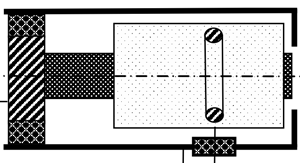Estimating of current rise time of glow discharge in triode electrode system in case of control pulsing
DOI:
https://doi.org/10.3103/S0735272713120066Keywords:
electrons sources of high-voltage glow discharge, pulse mode, anode plasmaAbstract
There are represented relations for approximate estimation of discharge current rise time in triode electrode systems of high-voltage glow discharge in case of applying of control pulses to auxiliary electrode. Theoretical transient analysis of high-voltage glow discharge is based on definition of the anode plasma volume and its ions concentration. Represented calculations show current rise time in real systems of high-voltage glow discharge is from 20 to 250 μs. Obtained results have great practical value for design of cathode-ray equipment.
References
- DENBNOVETSKIY, S.V.; MELNIK, V.I.; MELNYK, I.V. TUGAY, B.A. Gas-discharge electron guns and their application in industrial fields. Elektronika i Svyaz’, Part 2, p.84-87, 2005.
- LADOKHIN, S.V.; LEVITSKIY, N.I.; CHERNYAVSKIY, V.B.; SHMIDIGIN, V.G.; KRAVCHUK, L.A.; GLADKOV, A.S. Cathode-Ray Fusing In Foundry Engineering. Kyiv: Stal, 2007 [in Russian].
- ZAVYALOV, M.A.; KREYNDEL, YU.YE.; NOVIKOV, A.A.; SHANTURIN, L.P. Plasmic Processes in Technological Electron Guns. Moscow: Energoatomizdat, 1989 [in Russian].
- MELNYK, I.V. AND TUGAY, S.B. Analytical calculations of anode plasma position in high-voltage discharge range in case of auxiliary discharge firing. Izv. Vyssh. Uchebn. Zaved., Radioelektron., v.55, n.11, p.50-59, 2012 [in Russian]. Radioelectron. Commun. Syst., v.55, n.11, p.514-521, 2012. doi: 10.3103/S0735272712110064.
- MELNYK, I.V. AND TUGAY, S.B. Simulation of volt-ampere characteristics of non-independent additional discharge in triode gas discharge electron guns. Elektronnoe Modelirovanie, v.34, n.5, p.103-114, 2012.
- SCHILLER, S.; HEISIG, U.; PANZER, S. Electron Beam Technology. New York: Wiley, 1982.
- RYKALIN, N.N.; UGLOV, A.A.; ONISCHENKO, L.N. High-Temperature Technology Processes. Thermalphysic Principles. Moscow: Nauka, 1986 [in Russian].
- DENBNOVETSKY, S.V.; MELNIK, V.I.; MELNIK, I.V.; TUGAY, B.A. Investigation of forming of electron beam in glow discharge electron guns with additional electrode. Proc. of XVIII Int. Symp. on Discharges and Electrical Insulation in Vacuum, ISDEIV, 17–21 August 1998, Eindhoven, The Netherlands. Eindhoven Technical University, 1998, v.2, p.637-640. doi: http://dx.doi.org/10.1109/DEIV.1998.738827">10.1109/DEIV.1998.738827.
- NOVIKOV, A.A. Sources of Electrons of High-Voltage Glow Discharge with Anode Plasma. Moscow: Energoatomizdat, 1983 [in Russian].
- RAIZER, YU.P. Gas Discharge Physics. Springer, 1991.
- GRANOVSKIY, V.L. Electric Current in a Gas. Steady-State Current. Moscow: Nauka, 1971 [in Russian].
- KOROLEV, Y.D. AND MESYATS, G.A. Physics of Pulsed Breakdown in Gases. Moscow: URO-Press, 1991 [in Russian].
- TUTYK, V.A. Research of delay of high-voltage glow discharge firing for increase of gas discharge electron guns operating pressure. DAN Ukraine, n.11, p.86-91, 2008.
- HOCKNEY, R.W. AND EASTWOOD, J.W. Computer Simulation Using Particles. Taylor & Francis, 1989.
- BOLDASOV, V.S.; ZHELUBENKOV, YE.A.; KUZMICHEV, A.I. Transient processes in high-voltage gas-discharge systems of low pressure. Radiotekh. Elektron., v.35, n.11, p.2397-2401, 1990.
- MELNYK, I.V. AND TUGAI, S.B. Anode plasma boundary geometry modeling in high-voltage glow discharge triode electrode systems using the photograph computer analysis. Elektronnoe Modelirovanie, v.34, n.1, p.15-28, 2012.

Downloads
Published
2013-12-18
Issue
Section
Research Articles

